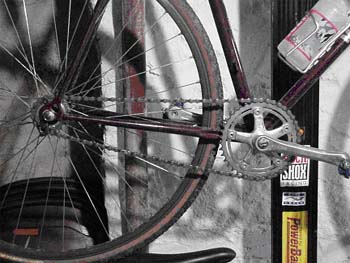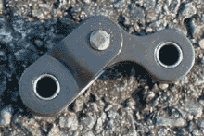[ 63XC.COM | HOW TO | MAGIC GEAR ]
Magic Gears and Half Links
When a gearie asks if the old beater that's been gathering dust in their basement for the past seven years can be converted to a singlespeed, the S/Ser's standard response is "Hell, yeah!" Anything can be turned into a singlespeed. But what about the former gearie who fully embraces the dark side and decides that they want to go fixed? This time, the conversation takes a different turn. They're likely to be told "You'll need a frame with horizontal dropouts." That standard response wasn't good enough for me. I had a couple of half-decent frames that I wasn't quite ready to give up on. That, and I'm cheap. The frames were a '94 Merlin Mountain that I'd been running as a S/S for a year or two, and an older Motobecane road frame that I'd gotten for free a while back. I wanted to change to a flip-flop on the Merlin. The Moto I planned to convert into a fixie commuter/pub crawler. I already had a good 700c fixie wheelset, and I wasn't about to buy a new beater frame on eBay when I had a perfectly good one at home that hadn't cost me a dime. So the journey began. My conclusion is that any bike can become a fix. There's no doubt that horizontal dropouts are ideal, but, with application and a little know-how, a frame with vertical dropouts is perfectly suitable. In order to make it work, you'll need a selection of old chainrings and sprockets. You'll likely get through a lot of sprockets, so it's smart to scavenge some old cassette freewheels for cogs. You'll also need two chains, one brand new, the other about halfway through its lifespan. And you'll need to do some math. You may also want to keep a few bottles of your favorite beverage handy, just in case. The theory The starting point of any discussion about chainlength has to be the chain itself, because the design of a bicycle chain allows only certain combinations of components to work in any given fixed gear/vertical dropout combination. Current chains are half-inch pitch, meaning that exactly half an inch separates the centers of the pins. Chains are made up of blocks, either inner, with rollers, or outer, with pins. A full link comprises two blocks, one inner and one outer. Thus, adding a full link to your chain lengthens it by exactly one inch. Take another look at the transmission on my Merlin. I've divided the chain's run into four sections.
Let's be formal about it. L = Du + Dl + Db + Ds where Notice that the model isn't quite right--Dl and Du aren't exactly equal to the length of the stay. But it's close enough. One of the advantages of this kind of approximation is that it enables you to make predictions about the behaviour of the system you're looking at without getting into too much detail. Seeing as the Merlin has vertical dropouts, Du and Dl aren't going to vary. All the action will be with Db and Ds. So what useful predictions can we make about the chainring and sprocket? Well, the first concerns the relationship between Db and Ds, the chainruns around the chainring and the sprocket. Let's say that I want to change the 34x17 setup on the Merlin. If I go to a 16t sprocket, Ds will get smaller. Assuming that all the other measurements remain unchanged, the hub will need to move backwards to take up slack. Likely I won't be able to make the new setup work in the Merlin's vertical dropouts. But if I also switch out the chainring, going up one tooth, that will take up the slack without moving the hub. If a 34x17 setup works, a 35x16 will too. So will a 36x15, or a 33x18. I can fine-tune my gear in small increments without affecting the hub placement, as long as the total number of teeth on the chainring and sprocket remains unchanged. The second prediction is a little more involved. It concerns the relationship between sprocket or chainring size and hub axle placement. Let's look at the sprocket a little more closely. Ds, the distance the chain travels along the sprocket, is about half Cs, the circumference of the sprocket. Ds = 1/2 Cs Now, let's increase the size of the sprocket by one tooth. The new circumference, Cs', will be exactly 1/2" bigger than the old. What will be Ds', the new chainrun? Ds' = 1/2 Cs' = 1/2 (Cs + 1/2") = 1/2 Cs + 1/4" Adding a tooth to the sprocket will add 1/4" to the distance the chain has to travel around the sprocket. If the total chainlength is unchanged, the chain will effectively shorten by 1/4"--but this distance will be made up along both the upper and lower chain runs, Du and Dl. The axle will need to move forward by 1/8" to maintain chain tension. So theory predicts that each one tooth change in the size of the sprocket will move the hub axle by 1/8", all things being equal. The same will be true of the chainring, of course. The practice Having seen the theory, let's do it for real. Start by figuring out the gear you'd like to run, then look through the parts drawer and see how close you can get. Remember that worn chain? Dig it out. The wear will give you some leeway for experiment. Build up the transmission on the bike. How does it look? Likely, the hub won't quite hit the slot. If the error is more than 1/2", add or remove a whole link from the chain and try again. If the error is less than 1/2", change the sprocket. You'll likely need to go round the loop a few times. It's a trial and error process. Patience. Brewskis. For real OK, so you've made your gear combination work with old parts. But you're not done yet. First, if you used a recycled cassette cog, replace it with a proper sprocket. The extra height on the teeth will help keep the chain in place, even with a little slack. Second, swap out the worn chain for a new one. Both these actions will help keep the chain on the bike when you hit the trail. A floppy chain is a dropped chain, and we all know what that means on a moving bike. (Although I must say that I've never dropped a chain using this kind of setup, whether commuting or racing offroad.) And remember: since you can't adjust tension by repositioning the hub, you'll need to replace your chain regularly. Halflinks Of course, it's not impossible that you never got beyond the test build. Maybe you simply couldn't find a gear combination that worked for you and for the bike. If so, you might try a halflink. These little devils are a mutant half-breed between an inner block and an outer, accomplishing 1" worth of work in 1/2" of space. In my case, this allows me to fine-tune the Merlin to a 32x17 gear instead of the standard 34x17 2:1 I've been running.
Halflinks can be tough to find. In my KC hometown, I've turned them up at a lawnmower shop and a hardware store. (You won't find them at Lowes or Home Depot though--look for the smaller stores that carry off-the-wall stuff.) When you do find a halflink, it's invariably in the old 1/8" width. This will force you to use BMX or track chain, and you may want to go to matching 1/8" sprockets and rings. I have had some success at re-engineering halflinks to 3/32" spacing, taking them apart on a vice, swapping the bushings and grinding down the connecting pins with a Dremel tool. But I'm certainly not recommending that you try it! Let's be careful out there. [ TOP ] |
Writer
Todd lives in Kansas City, and when he's not playing in the sewers, he's riding a fixed gear around the streets and trails of KC.
Date
v1.1 written May 2003, August 2004
Images
Todd took the first two photos himself, but the halflink is used by kind permission of Alliance Bikes in Canada.
Related
Todd has kindly let us publish his magic gear spreadsheet. You'll need MS Excel.
Both Sheldon in the US and St John St in the UK now stock halflinks in 3/32".
Not sure where you can find an appropriate FG hub? Try our hub choice article.
Legal
You are your own mechanic and you work at your own risk. 63xc.com and Todd Posson will not be held liable for any damage or injury arising from use of the techniques described in this article.
Mailing list
Join the 63xc.com list.


